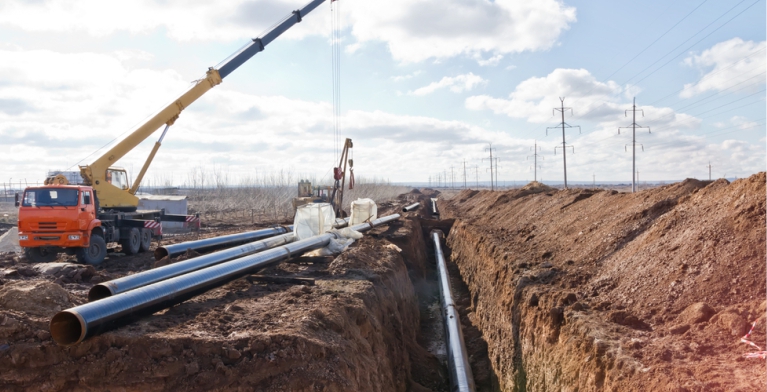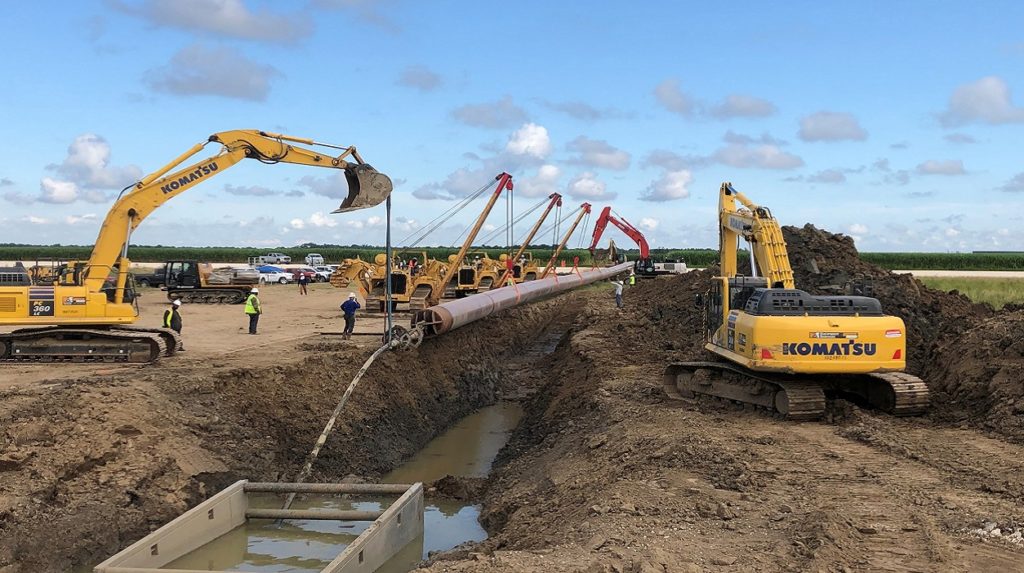What Sets Creek Pipe Midland Is a Go-To Choice for Texas Installations
What You Must Understand About Pipe Trenching Solutions: A Comprehensive Summary of Available Options
Pipe trenching solutions are essential for the setup and maintenance of below ground utilities. They entail different methods customized to details needs and environments. Understanding these techniques is key for reliable job execution. Each alternative presents its own set of advantages and obstacles. As the demand for efficient utility administration rises, knowing what to take into consideration when picking a trenching solution comes to be necessary. What variables should one prioritize to guarantee success?
Recognizing Pipe Trenching: What It Is and Why It Matters
Although commonly ignored, pipe trenching is a vital procedure in numerous construction and utility projects. This strategy entails excavating narrow trenches to promote the installment of pipelines for water, gas, sewage, and telecommunications. The importance of pipeline trenching hinges on its function in making sure that these crucial systems are properly incorporated right into facilities, allowing the risk-free and effective shipment of essential services.Proper trenching is crucial for preserving the integrity of pipes and reducing dangers related to dirt disintegration and cave-ins. It additionally enables effective inspections and maintenance of underground utilities. In addition, comprehending the neighborhood regulations and ecological factors to consider is vital, as inappropriate trenching can bring about pricey hold-ups and lawful problems. Ultimately, pipe trenching serves as the foundational action that supports various construction undertakings, making it a substantial aspect of modern facilities growth.
Usual Trenching Methods for Below Ground Energies
In the domain name of underground utilities, numerous trenching approaches play an essential duty in installment and maintenance - Creek Pipe Midland. The open-cut trenching approach, directional dull method, and hydro excavation procedure each offer one-of-a-kind advantages depending upon the specific project needs. Recognizing these approaches is essential for reliable and effective utility administration
Open-Cut Trenching Approach
Open-cut trenching is a commonly made use of approach for mounting underground utilities, particularly when the depth and size of the trench allow for efficient gain access to. This strategy includes excavating a trench along the suggested path of the utility, giving straight presence and accessibility for installment. It is particularly advantageous for projects that require considerable excavation, as it promotes fast installation and examination. However, it also requires careful preparation to lessen disruption to the surrounding location, including website traffic and existing structures. Open-cut trenching is most effective in open areas where the dirt problems agree with, however it might be limited in metropolitan atmospheres due to the visibility of existing utilities and various other below ground obstacles.
Directional Boring Technique

Hydro Excavation Refine
Exactly how does hydro excavation stand out among usual trenching methods for below ground utilities? Hydro excavation utilizes high-pressure water and vacuum technology to safely get rid of dirt, enabling exact digging around sensitive underground energies. This approach minimizes the threat of damaging existing facilities contrasted to conventional mechanical excavation. By employing water to loosen the soil, hydro excavation provides a much less intrusive strategy, decreasing the possibility for soil compaction and guaranteeing a cleaner worksite. Additionally, the process boosts presence throughout excavation, improving general precision and effectiveness. Hydro excavation is especially beneficial in metropolitan locations where energy lines are densely packed, making it a preferred choice for professionals focused on safety and precision in below ground tasks.
Advantages of Trenching Providers
While numerous approaches exist for installing underground utilities, trenching solutions offer unique advantages that make them a preferred choice for lots of tasks. One considerable advantage is the cost-effectiveness of trenching, as it typically calls for much less specialized devices contrasted to alternatives like hydro excavation. This commonly causes lower labor and operational costs. Additionally, trenching can fit a vast array of energy kinds, including water, sewage system, and gas lines, giving flexibility for contractors.Moreover, trenching allows for effective accessibility to numerous lines in a single excavation, lessening interruption to the surrounding area. The procedure also makes it possible for exact installment and fixing, which is essential for sticking to governing criteria and ensuring long-term reliability. Ultimately, trenching can be executed reasonably swiftly, minimizing task timelines and enabling faster service repair. These advantages collectively make trenching solutions a useful option for many underground energy tasks.
Downsides and Obstacles of Trenching
Regardless of the countless benefits of trenching solutions, there are notable negative aspects and challenges that need to be thought about. One significant challenge is the potential for dirt instability, which can bring about cave-ins, presenting threats to employees and tools. Additionally, trenching can interrupt existing utility lines, demanding careful planning and sychronisation to stay clear of solution disruptions. The procedure can likewise be taxing, particularly in city locations where room is restricted and access is restricted. Furthermore, trenching may call for substantial permits and governing compliance, adding intricacy and potential delays to projects. Ecological issues, such as dirt erosion and damage to regional environments, can emerge from inappropriate trenching methods. The expenses associated with trenching, consisting of labor and equipment, can intensify if unanticipated issues occur during the project, making it crucial for stakeholders to weigh these difficulties versus the advantages when taking into consideration trenching services.
Key Variables to Think About When Choosing a Trenching Solution
Selecting the best trenching service can substantially impact the success of a project. Numerous crucial aspects should be assessed to assure an ideal option. The business's experience and knowledge in trenching operations are necessary; a reputable service with a solid track record is usually much more trustworthy. Next, evaluating the devices made use of is fundamental, as modern machinery can enhance efficiency and accuracy. Additionally, it is substantial to take right into account the variety of solutions offered, including excavation deepness and dirt type handling, to validate they fulfill specific task requirements.Another element to evaluation is the business's track record; client evaluations and endorsements can offer understandings into previous efficiency. Obtaining detailed quotes that outline expenses and timelines will certainly aid in spending plan management. Verifying compliance with local guidelines and market standards is important for avoiding More Help possible legal problems. By reviewing these factors, clients can make an informed choice when selecting a trenching service.
Precaution in Pipe Trenching
In pipeline trenching, precaution are critical to ensuring worker protection and website stability. Key elements include using personal safety devices, complete excavation site examinations, and distinct emergency reaction protocols. Carrying out these procedures substantially lowers threats connected with trenching procedures.
Individual Safety Equipment
Security in pipe trenching greatly depends on the proper use of personal safety devices (PPE) Workers must wear tough hats to safeguard versus falling things, along with high-visibility vests to boost their exposure on-site. Steel-toed boots are crucial for foot protection versus hefty equipment and products. Additionally, gloves are vital for hand security, specifically when dealing with harsh or sharp things. Respirators may additionally be required in settings with dirt or unsafe fumes. Eye security, such as security goggles, should be used to protect against particles. Lastly, hearing protection is vital in noisy job atmospheres. By sticking to PPE standards, workers can significantly minimize the danger of injury and ensure a much safer trenching procedure.
Excavation Website Evaluation
Properly evaluating the excavation site is a basic action in guaranteeing a risk-free pipe trenching procedure. This process includes evaluating the website for potential threats such as underground energies, unstable dirt conditions, and neighboring structures. A comprehensive analysis permits the recognition of risks that might endanger worker safety and security. Additionally, validating the dirt type and dampness degrees can help establish suitable shoring techniques to avoid trench collapses. It is necessary to assure that the site is clear of particles which correct signage is presented to alert workers of recurring operations. Regular assessments throughout the project can likewise assist identify any type of adjustments in site conditions, allowing prompt changes to precaution and job protocols.

Emergency Situation Feedback Protocols
Emergency situation feedback procedures are crucial in mitigating threats connected with pipeline trenching operations. These procedures guarantee that all personnel are prepared to act promptly and properly in emergency situations. Secret components include normal security drills, clear communication channels, and marked fire escape. Furthermore, first-aid packages and emergency situation get in touch with numbers should be conveniently obtainable on-site. Trenching operations must additionally include procedures for managing harmful circumstances, such as collapses or energy strikes. Training employees on recognizing potential threats website here and recognizing their roles throughout an emergency situation is essential. Keeping an updated site safety strategy can substantially boost response performance. Generally, effective emergency situation preparedness promotes a safer working setting and reduces the impact of unforeseen incidents.
Expense Factors To Consider for Trenching Services
Comprehending the economic ramifications of trenching services is crucial for job preparation and budgeting. The costs linked with trenching can vary widely based on several aspects, consisting of task dimension, soil type, and deepness of the trench. Labor prices frequently stand for a substantial portion of the overall expenditure, as competent operators are required for efficient implementation. In addition, tools rental fees can add to the overall budget, especially for specialized machinery.Site ease of access is one more essential element; hard surface might demand added sources, boosting expenses. Permitting and regulatory compliance can additionally contribute to expenditures, especially in metropolitan areas where policies are stringent.Lastly, unexpected problems, such as experiencing existing utilities, can bring about unanticipated prices and hold-ups. Therefore, acquiring comprehensive estimates from respectable trenching provider is essential for exact budgeting and making sure successful task completion.
Frequently Asked Inquiries
How much time Does a Regular Pipe Trenching Job Take?
The duration of a typical pipeline trenching job varies substantially based on variables such as depth, dirt conditions, and task intricacy. Generally, it can take anywhere from a couple of days to a number of weeks to complete.
What Devices Is Generally Used in Pipe Trenching?

Are There Environmental Rules for Trenching Activities?
Environmental guidelines for trenching tasks usually require compliance with local, state, and federal standards. These regulations aim to minimize ecological disruption, protect water sources, and guarantee proper waste management throughout excavation and installment procedures.
Can Trenching Providers Be Integrated With Other Building Jobs?
Trenching services can indeed be incorporated with numerous building jobs. By coordinating initiatives, efficiencies can be achieved, go to this site minimizing disturbances while making sure that all required infrastructure job is finished in a timely and cost-effective fashion.
What Prevail Soil Keys In Come Across in Trenching?
Common dirt types encountered in trenching consist of clay, sand, silt, and loam. Each type offers special challenges, influencing excavation techniques and security, requiring careful preparation to guarantee secure and effective trenching procedures.